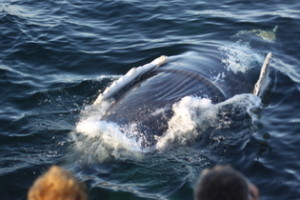Dolphin Fleet Naturalist Notebook 12 September to 18 September
12 September– Trips cancelled due to high seas
13 September–Sunday morning was overcast with offshore fog and choppy seas. We traveled to the southeast corner of Stellwagen Bank, where despite foggy conditions, we sighted Minke and humpback whales. In the morning, the humpbacks were surface feeding on krill, a small, shrimp-like marine animal. Krill are important zooplankton, particularly as they are food for some species of baleen whales, sharks, seals and seabirds. The name krill comes from the Norwegian word krill meaning “young fry (recently hatched fish) of fish”. Krill occur in all oceans of the world and are an important trophic (relating to nutrition) connection because they feed on phytoplankton (microscopic plants) and to a lesser extent on smaller zooplankton. By the afternoon and sunset watches the fog began to clear but the surface feeding had ended. The whales were diving longer and surfacing energetically- a possible sign that the krill or small fish were well beneath the surface. Humpback sightings included Gladiator, Spotlight, Canopy, Eruption, Citation, several small, unknown humpbacks and Rattan and her first calf.
14 September– Monday was bright and hazy with light Northwest winds. We traveled to the triangle- off the southeastern edge of Stellwagen Bank. The humpback whales again were on long dives but there were several mothers and calves in the area. While the adults were on deep dives, some of the calves stayed on the surface, rolling about. The calves are born in the warm waters of the Caribbean Sea during the winter and are able to swim immediately while learning how to nurse on the fat-rich milk of their mothers. They gain about 100 pounds (45.5 kg) per day. In early spring, mothers and calves began the long migration across the open ocean to the waters off Cape Cod. After fasting in the Caribbean, the females need to eat and the calves now have enough blubber for cold water. By September, the calves are between 5 and 9 months old and have begun to learn how to catch the small fish and shrimp that will sustain them for the rest of their lives. In a few months, the calves will be weaned, and shortly after, most will separate from their mothers. In future years, they will roam the same feeding grounds, but will rarely spend time traveling together. As the calves mature and survive the long migration, they will return to the waters off Cape Cod to feed and females, when mature, will return with calves of their own. Humpback sightings includes Thumper, Lavaliere, Palette, Pisces and an unknown mother and their calves, Ragweed, Buzzard, Xylem, Condensation, Crown and Pivot.
An unidentified mother humpback flukes
15 September– Tuesday was bright with calm seas. Our watches today were on Stellwagen Bank. During the morning we sighted Nile and her 4th calf. Nile, born to Mars in 1987, has spent the better part of the summer near the southwest corner of the Bank with her calf. On this morning the calf was very active, lobtailing, breaching and flipper slapping. If you are curious about whale behavior, what the whales are doing and why, so are the scientists that study them! Whale behavior for the most part remains a mystery. While the tail breaching and flippering behavior of the calf may be learning or play, there are many theories about why juveniles and adults jump and flipper slap. They range from exercise, to communication and play to aggression and territorial displays. By afternoon and early evening, more humpbacks moved into the area. Spirit, born in 2007 to Strike, and a small unknown whale occasionally were surface feeding on krill. Most of the whales however seemed to be feeding deep. Nile, Anvil and Lavaliere and their calves were traveling up the Bank along with Spirit and 3 to 4 small unknown whales.
16 September– High winds. Although bright the winds were strong from the Northeast. We ventured to the southern edge of Stellwagen Bank and sighted 4 humpback whales. The seas continued to build and the whales were very active- jumping out of the water continuously. We returned to port, earning our sea legs! The afternoon watches were cancelled as the wind increased in strength.
A calf breaches as seas continue to build
17 September– Trips cancelled due to high seas
18 September– A bright, cool day with Northwesterly winds. The seas have finally subsided and we venture offshore after a few days on land. During the morning, the whales were scattered over a wide area in the triangle. Most of the humpbacks were traveling throughout the area, occasionally slowing down to feed. A mother and calf swim by the Dolphin VIII. We are able to photograph the pair but the mother is unknown to our scientists- not a whale that we have sighted in previous years. She and her calf have been seen several times over the last two months. During the afternoon we photograph Tulip, Apex and Blackhole and their calves. Apex’s calf remained on the surface, continually flippering while the adults moved about the area and spent long periods of time underwater. Tunguska, Circuit, Thread, Salt and Cardhu also were in the area and deep diving.
Apex’s calf rolls near boat
On the sunset watch, we photographed many of the same whales sighted in the afternoon, with the addition of Follicle and calf and Bayou. Bayou, born in 2006 to Trident, was struck by a small boat sometime during the summer, damaging the right side of its fluke. It is a tragic reminder of the need for responsible navigation by all vessels in the vicinity of whales.
Bayou
We return to Provincetown amidst a spectacular sunset.










